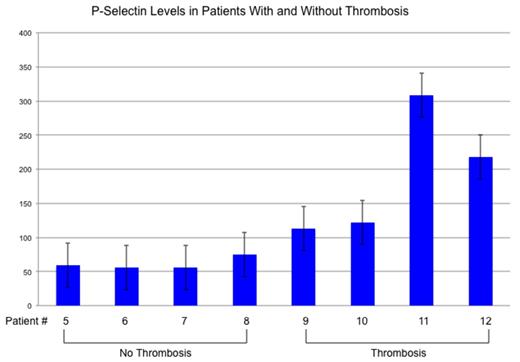Abstract
Thrombosis is a major cause of morbidity and mortality in the Philadelphia-chromosome negative myeloproliferative neoplasms (MPN). However, the pathogenesis of thrombosis in patients with MPN is poorly understood. MPNs are associated with elevated levels of inflammatory cytokines and abnormal platelet activation including elevated platelet factor 4 (PF4), B-thromboglobulin (B-TG) and p-selectin levels. However the relationship between these inflammatory markers and the onset of thrombosis is unclear. Current treatment guidelines recommend the use of cytoreductive agents to decrease thrombosis risk based on history of prior thrombosis and age. The effect of cytoreduction on inflammatory markers has only been partially characterized. Furthermore, current clinical guidelines fail to predict thrombotic events in all patients. Thus, more accurate risk stratification is necessary.
To determine if levels of p-selectin and PF4 correlate with thrombotic events and if levels of p-selectin and PF4 are affected by cytoreductive therapy.
Biobanked samples from 16 patients with a confirmed diagnosis of chronic phase MPN (per WHO 2008 criteria) were included in this study. Seven patients had primary myelofibrosis, five had polycythemia vera, and four had essential thrombocythemia. Median age of patients was 65.5 (range 44-81). Fourteen patients had a JAK2 V617F mutation. Four patients with samples collected before and after thrombotic episodes, four patients with post-thrombotic samples, four without a history of thrombosis, and four patients with samples obtained before and after cytoreduction were analyzed. Patient characteristics are summarized in Table 1. Plasma samples were analyzed for levels of PF4 and p-selectin using commercially-available ELISA assays under standard conditions.
Measurement of p-selectin levels in MPN patients with a history of a thrombotic event versus disease matched control MPN patients with no history of thrombosis demonstrated an increase in the level of p-selectin in patients with thrombosis. Elevated levels of PF4 were noted in only one patient who had a history of thrombosis, and who was maintained on Aspirin. This suggests that elevated levels of p-selectin may be an indicator of thrombosis risk in patients with MPN.
Levels of PF4 and p-selectin were next assessed in patients who had suffered a thrombotic event, both before and after the event had occurred. No changes in p-selectin or PF4 levels pre and post thrombosis were noted.
The effect of cytoreduction was measured using samples from patients pre- and post-cytoreduction. No differences in the level of PF4 were noted with cytoreduction. In contrast, reductions in p-selectin were noted in two patients in whom cytoreduction was achieved with Ruxolitinib, but not in two patients in whom cytoreduced with hydroxyurea or pomalidomide. This suggesting that Ruxolitinib may have role in thrombosis risk reduction.
Platelet levels were recorded for all 16 patients. There was no difference in platelet levels in each group of patients. In contrast to the changes observed with p-selectin, there was no difference in platelet levels in patients with out a thrombotic event compared to those with a history of thrombosis. This suggests that platelet activation, as measured by p-selectin, may be a stronger indicator of thrombotic risk than platelet levels.
Improvements in risk stratification of thrombotic risk for patients with MPN are needed. Platelet activation in MPNs is abnormal and may serve as an additional marker of thrombotic risk. Our results suggest that levels of p-selectin, but not PF4, may be associated with increased thrombotic risk. Furthermore, treatment with the JAK1/2 inhibitor Ruxolitinib resulted in reduction in levels of p-selectin, suggesting that the role of Ruxolitinib in preventing thrombotic event should be further investigated. Additional studies with larger numbers are in progress to validate these results.
Rampal:Foundation Medicine: Consultancy.
Author notes
Asterisk with author names denotes non-ASH members.



